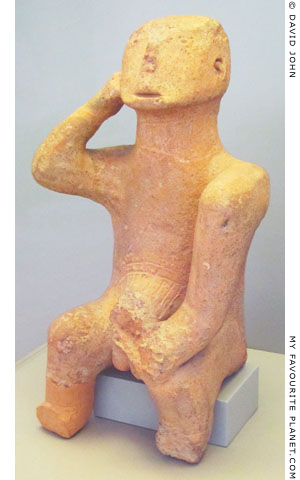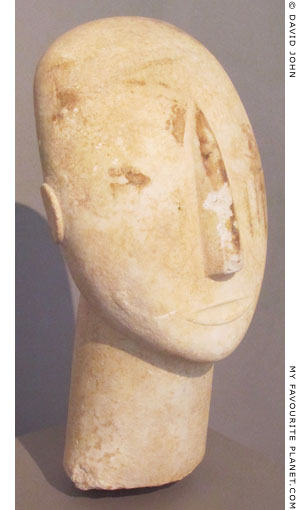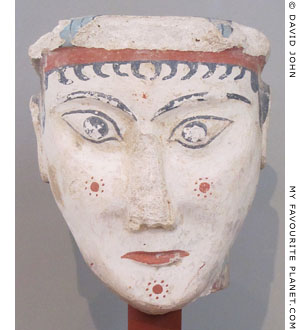|
|
|
| My Favourite Planet > English > People > Ancient Greek artists |
| MFP People |
Ancient Greek artists – page 1 |
 |
Page 1 of 14 |
 |
|
| |
Ancient Greek artists
Version 002, March 2020.
Last updated 15 October 2021.
A work in progress - see introduction below |
| |
| Contents |
| |
|
| |
As ever, comments, criticisms, suggestions
and contributions to this project are welcome.
Please get in contact. |
| |
Ancient Greek
artists |
Introduction |
|
 |
|
| Ancient Greek artists – a work in progress |
| |
Although there is an abundance of ancient Greek pottery in world museums and collections, very few original sculptures, paintings or mosaics by ancient Greek artists have survived, and most works are known from Roman period copies. The artists seldom signed their works, and many signatures on statues and bases are questionable or were later forgeries.
Several ancient writers, including Pausanias, Plutarch, Pliny the Elder and Lucian of Samosata, mention artworks and name artists who were presumably well-known to the educated readers of their time, but many remain a puzzle to modern scholars. Since the Renaissance historians and archaeologists have attempted to identify the makers and origins of extant works of art, often causing a great deal of debate and controversy in the academic world.
The arrangements of book, chapter and section of the works of some ancient authors vary in different modern published editions and online versions. We shall attempt, where possible, to refer to a single source for each author and provide links to the respective passages online.
We will also provide links to information and images of artists and works on this and other websites, as well as bibliographic details for modern publications. As a start, see
page 14, Bibliography. |
| |
| Ancient Greek pottery |
| |
Because of the large numbers of surviving ancient Greek "vases", discovered and collected since at least the 15th century across an enormous geographical area (from across Europe, all around the Mediterranean and into north Africa and central Asia), the subject has been studied and written about by many scholars. It is therefore not surprising that there are many theories and a lot of specialized terminology and jargon, which we are unable to deal with in detail here.
Pottery has been described as "indestructable" - at least the baked clay substance - but most often only shards or smashed ancient ceramic objects have been found, and where possible fragments have been carefully restored. Still, it is surprising how many have remained intact, usually those buried as grave goods or as votive offerings to deities, or even deliberately hidden with other objects (coins, valuables, statues, etc) in stashes at times of crisis by owners who believed they may return to recover their possessions. Many pots have astoundingly retained their lustre, colours and painted details over thousands of years. In Sicilian archaeological museums such as Catania, Syracuse, Gela and Argigento, for example, the vast majority of exhibits are vases, many in excellent condition.
Pottery has been made and traded since Neolithic times, for basic daily use, special communal and religious functions, as jewellery and decoration, and for pleasure. From the basic shapes of early ceramics, makers experimented to produce particular forms for practical and aesthetic purposes. Apart from vessels for storage, eating and drinking, there were also ceramic plaques, tiles, bricks, beads, toys, statues, figurines and reliefs (see, for example, a painted Corinthian ceramic pinax, 630-610 BC). Decoration also evolved from simple indents and grooves made with fingers and thumbs and incisions scratched with sticks, to exquisitely drawn, painted and glazed works of art.
However, since the field of ceramic objects in general is so vast, many scholars of ancient Greek pottery confine themselves to the "vases", which include vessels such as amphorae and kraters (there are over 24 main basic shapes with numerous variations). The continuity of development in form and decoration of Greek pottery can now be charted, particularly from the Archaic period (8th - 5th centuries BC) onwards, and especially in the case "Attic" pottery from Athens, much of which was made for export around the Mediterranean.
Unlike sculptors, painters and architects, potters and vase painters were not named or praised by ancient authors. A small number of vases were signed by the potter, the painter or both, so that those responsible for unsigned pots can sometimes be identified by examining style, form, materials and finish in comparison to signed vessels. In the case where a painter's name is unknown, a name is often given by scholars based on personal styles or idiosyncrasies evident in one or more pieces, the potter for whom they worked (e.g. the Sosias Painter, who worked for Sosias the potter), the current location of an exemplary work (in a collection or museum, e.g. the Berlin Painter) or the depiction of a particular subject, theme or motif (e.g. the Orpheus Painter). In some case artists are identified as members of groups, often thought to have worked in the same workshop, due to similarities in style, technique, subjects or particular types of vessels (e.g. the Pioneer Group, the Cock Group). This system was devised by the Oxford-based scholar Sir John Davidson Beazley (1885-1970), who identified around 500 potters, vase painters, groups and workshops. The key pottery vessel from which the name of the painter has been identified is known as the "name vase".
A name given by scholars to an unidentified artist in any medium is often referred to as the "Notname" (provisional name), from the German word Not, meaning emergency.
The identification of the date and place of manufacture of ceramics is based mainly on the types of clay and decorative materials (e.g. colours) used, the forms of the objects and the kinds of decoration. From the Archaic period vases were produced commercially in great numbers, especially in Corinth, Athens and Magna Graecia (southern Italy). Particular types of images and motifs were apparently popular among painters and customers in various areas at different periods.
Figural subjects included mythological and religious themes, as well as scenes of religious ritual, marriages, funerals, sport, war, theatrical performances and various aspects of daily life. Many images are detailed, graphic and sometimes dramatic, while others are more general and to the modern observer vague. A vast number of vase paintings appear to us more prosaic, mass-produced stock images of heads of humans or horses, standing or seated figures and similar isolated subjects. Although the significance of these is mostly lost on us today, they provide experts with valuable evidence concerning potters and painters, as well as trends in taste and production. Having studied thousands of such vases, the classical pottery expert Arthur Dale Trendall, paraphrasing Mary Tudor, complained, "when I die, they will find, engraved on my heart, 'two draped youths'." *
* D. Williams, Dale Trendall: The eye of an eagle, BICS 41, 1996, page 16. Quoted by Michael Turner, The Australian Archaeological Institute at Athens, in his review of Corpus Vasorum Antiquorum, Deutschland, Band 76, 1. Bryn Mawr Classical Review 2005.08.30. |
|

"The Thinker", a solid ceramic
figurine of a seated man.
From the area of Karditsa, Thessaly,
central Greece. Final Neolithic period,
4500-3300 BC.
National Archaeological Museum,
Athens. Inv. No. 5894. |
| |

The head of a marble Cycladic statue,
with painted eyes and four red vertical
striations on the left cheek.
Found on the island of Amorgos, Cyclades.
Early Cycladic II period (Keros-Syros
Culture), 2800-2300 BC. Parian marble.
National Archaeological Museum,
Athens. Inv. No. 3909. |
| |

A painted plaster head of a woman
wearing a polos, perhaps a goddess
or sphinx. One of the few surviving
examples of Mycenaean monumental
plastic art.
13th century BC. From the area of the
Cult Centre on the acropolis of Mycenae.
National Archaeological Museum,
Athens. Inv. No. 4575. |
| |
| |

Greek gold foil relief of a round dance. 7th century BC.
Altes Museum, Berlin. |
| |
Ancient Greek
artists |
Index of artists |
|
 |
|
| Sculptors |
| |
Sculptors A - D
Adymos of Veroea
Aetion (of Amphipolis)
Ageladas of Argos
Agesander of Rhodes
Agorakritos of Paros
Alexandros of Antioch
Alkamenes
Alxenor
Anaxagoras of Aegina
Androsthenes
Antenor
Antiphanes of Argos
Antonianos of Aphrodisias
Apelleas, son of Kallikles
Apollonios, son of Archias
Apollonios and Tauriskos
Archelaos of Priene
Archermos of Chios
Aristeas and Papias
Aristion of Paros
Aristokles
Aristokles of Kydonia
Aristokles of Sikyon
Aristokles, son of Kleoitas
Askaros of Thebes
Athanadoros
Bathykles of Magnesia
Bryaxis
Bupalos
Chairestratos of Rhamnous
Chares of Lindos
Daidalos
Daidalos of Sikyon
Damatrios
Damophon
Deinokrates (or Stasikrates)
Demetrios of Alopece
Demetrios Pteleasios
Diogenes of Athens
Dionysos, son of Apollonios
Dipoenos and Skyllis
Doidalsas (or Daedalsas) |
Sculptors E - H
Endoios
Epigonos of Pergamon
Euphron
Euphranor of Corinth
Euthykartides
Euthykrates
Eutychides of Sikyon
Evandros of Veroea
Glaukias of Aegina
Glaukos of Argos
Glaukos of Chios
Glaukos of Samos
Glaukos of Lemnos
Glykon of Athens
Gorgias
Hegesias
Hegias of Athens or Hegesias
Hegias (Roman period)
Heliodoros of Rhodes
Hephaistos
Hermippos
Herophon |
Sculptors I - M
Iktinos
Iason the Athenian
Kalamis
Kallikles of Megara
Kallikrates
Kallimachos
Kallon of Aegina
Kallon of Elis
Kanachos of Sikyon, the Elder
Kanachos of Sikyon, the Younger
Kephisodotos the Elder
Kephisodotos the Younger
Klearchos of Rhegion
Kresilas
Kritios
Leochares
Lykios
Lysippos
Lysistratos of Sikyon
Lysos
Melas of Chios
Menas of Pergamon
Menekrates (of Rhodes)
Menestratos (of Athens)
Menestratos of Pergamon
Mikon of Syracuse
Mnesikles
Myron |
| |
Sculptors N - P
Naukydes of Argos
Nesiotes
Onatas of Aegina
Paionios of Mende
Pasiteles
Pheidias
Philathenaios
Philon, son of Emporion
Phyromachos (of Athens)
Phyromachos of Kephisia
Polycharmos
Polydoros
Polyeuktos
Polykleitos the Elder
Polykleitos the Younger
Polykleitos, son of Mothonos
Polykles
Polymedes of Argos
Pontios of Athens
Praxias and Androsthenes
Praxiteles
Pyrrhos of Athens
Pythagoras of Rhegion
Pythagoras of Samos
Pytheos (Pythis)
Pythokritos of Rhodes |
Sculptors R - Z
Rampin Master
Rhoikos of Samos
Skyllis
Skopas
Sokrates
Sostratos
Stasikrates (or Deinokrates)
Sthennis
Strongylion
Styppax
Theodoros of Samos
Theokosmos of Megara
Tauriskos of Tralles
Thrasymedes of Paros
Timarchos
Timotheos (of Epidauros)
Zenas son of Alexandros
Zenas son of Zenas
Xenophon of Athens
Zenodoros |
|
|
| |
| Potters / vase painters |
| |
Potters / vase painters A - D
Amasis and the Amasis Painter
Andokides Painter
Antimenes Painter
Aristonothos
Asteas
Berlin Painter
Boreas Painter
Brygos
Brygos Painter
Choregos Painter
Christie Painter
Cock Group
Darius Painter
Diphilos
Dodwell Painter
Dolon Painter |
Potters / vase painters E - H
Eucharides Painter
Euphiletos Painter
Euphronios
Exekias
Foundry Painter
Gela Painter
Hermonax |
| |
Potters / vase painters I - M
Iliupersis Painter
Lycurgus Painter
Lydos
Lydos "the slave"
Marsyas Painter
Micali Painter
Mykonos Painter |
Potters / vase painters N - S
Nessos Painter
Nikosthenes
Orpheus Painter
Polygnotos
Polyphemos Painter
Pourtalès Painter
Primato Painter
Psiax
Sophilos
Sosias
Sosias Painter
Syleus Painter
Syriskos Painter
Swing Painter |
|
| |
| Painters |
Mosaic artists |
Architects |
| |
Aetion (of Amphipolis)
Apelles
Aristeides of Thebes
Euphranor of Corinth
Helena of Egypt
Mikon the Elder of Athens
Mikon the Younger
Nikias
Panainos
Philoxenos of Eretria
Protogenes
Pythagoras of Paros
Pythagoras of Samos
Turpilius (Roman)
Zeuxis |
Amiteion
Antaios, son of Aiskerion
Asklepiades of Arados
Dioskourides of Samos
Gnoseis
Hephaistion
Heraklitos
Sophilos
Sosos
Zosimos |
Agamedes and Trophonios
Chersiphron
Deinokrates (or Stasikrates)
Hermodoros of Salamis
Iktinos
Mnesikles
Paionios of Ephesus
Philon of Eleusis
Polykleitos
Pytheos
Skopas
Sostratos of Knidos
Theodotes
(and Theodorus the Phocian) |
|
| |
Photos on the Ancient Greek artists pages were taken
during visits to the following museums and sites:
Germany
Berlin, Altes Museum
Berlin, Pergamon Museum
Dresden, Albertinum, Skulpturensammlung
Dresden, Staatliche Kunstsammlungen
Hamburg, Museum für Kunst und Gewerbe
Greece
Abdera Archaeological Museum
Aegina Archaeological Museum
Athens, Acropolis Museum
Athens, Agora Museum
Athens, Epigraphical Museum
Athens, Kerameikos Archaeological Museum
Athens, National Archaeological Museum
Corfu Archaeological Museum
Corinth Archaeological Museum
Delos Archaeological Museum
Delphi Archaeological Museum
Isthmia Archaeological Museum
Kos Archaeological Museum
Kos, Asklepieion archaeological site
Mycenae Archaeological Site and Museum
Mykonos Archaeological Museum
Olympia Archaeological Museum
Olympia, Museum of the History of the Ancient Olympic Games
Patras Archaeological Museum
Piraeus Archaeological Museum
Rhamnous Archaeological Site
Rhodes Archaeological Museum
Rhodes, Palace of the Grand Master
Thebes Archaeological Museum
Thessaloniki Archaeological Museum
Italy
Milan, Civic Archaeological Museum
Naples, National Archaeological Museum
Paestum Archaeological Museum
Rome, Barracco Museum
Rome, Capitoline Museums, Palazzo dei Conservatori
Rome, Capitoline Museums, Palazzo Nuovo
Rome, National Etruscan Museum, Villa Giulia
Rome, National Museum of Rome, Palazzo Altemps
Rome, National Museum of Rome, Palazzo Massimo alle Terme
Rome, Temple of Hercules Victor
Italy - Sicily
Agrigento Regional Archaeological Museum
Netherlands
Amsterdam, Allard Pierson Museum
Leiden, Rijksmuseum van Oudheden
Turkey
Bergama Archaeological Museum
Istanbul Archaeological Museum
Izmir Archaeological Museum
Izmir Museum of History and Art
United Kingdom
London, British Museum
Many thanks to the staff of these museums. |
|
|
Photos and articles © David John, except where otherwise specified.
Version 001 was first published online on 10 May 2016. |
 |
Visit the My Favourite Planet Group on Facebook.
Join the group, write a message or comment,
post photos and videos, start a discussion... |
|
|
| |
|
|
| |
| |
 |
| |
 |
| |
 |
| |
 |
| |
 |
| |
 |
| |
George Alvanos
rooms in
Kavala's historic Panagia District
Anthemiou 35,
Kavala, Greece
kavalarooms.gr
|
| |
Olive Garden Restaurant
Kastellorizo,
Greece
+30 22460 49 109
kastellorizo.de
|
| |
Papoutsis
Travel Agency
Kastellorizo,
Greece
+30 22460 49 286
greeklodgings.gr
|
| |
|